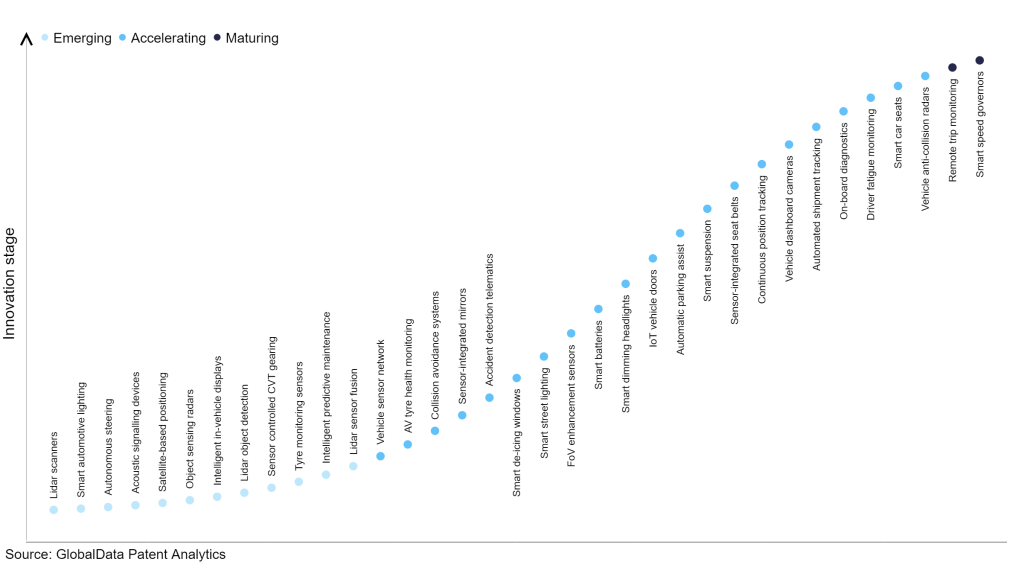The automotive industry continues to be a hotbed of patent innovation. Activity is driven by safety, customer demand, and environmental concerns, and growing importance of technologies such as artificial intelligence (AI) and machine learning, sensor integration, and wireless connectivity. In the last three years alone, there have been over 720,000 patents filed and granted in the automotive industry, according to GlobalData’s report on Internet of Things in automotive: smart de-icing windows. Buy the report here.

Discover B2B Marketing That Performs
Combine business intelligence and editorial excellence to reach engaged professionals across 36 leading media platforms.
However, not all innovations are equal and nor do they follow a constant upward trend. Instead, their evolution takes the form of an S-shaped curve that reflects their typical lifecycle from early emergence to accelerating adoption, before finally stabilizing and reaching maturity.
Identifying where a particular innovation is on this journey, especially those that are in the emerging and accelerating stages, is essential for understanding their current level of adoption and the likely future trajectory and impact they will have.
300+ innovations will shape the automotive industry
According to GlobalData’s Technology Foresights, which plots the S-curve for the automotive industry using innovation intensity models built on over one million patents, there are 300+ innovation areas that will shape the future of the industry.
Within the emerging innovation stage, autonomous steering, LiDAR scanners and intelligent predictive maintenance are disruptive technologies that are in the early stages of application and should be tracked closely. Sensor-integrated mirrors, smart street lighting and automatic parking assist are some of the accelerating innovation areas, where adoption has been steadily increasing. Among the maturing innovation areas are remote trip monitoring and smart speed governors, which are now well established in the industry.
Innovation S-curve for Internet of Things in the automotive industry

Smart de-icing windows is a key innovation area in Internet of Things
Smart de-icing windows are windows that have the ability to de-ice themselves using innovative technologies. These windows are equipped with electrically conductive components and solder, which help in de-icing the windows by melting ice and snow. The use of lead-free solder and mechanical stress modifiers ensures the prevention of stress faults in the glass and maintains the bonding strength between the glass and the metal components. These windows are widely used in automotive vehicles and provide convenient and efficient de-icing solutions.
GlobalData’s analysis also uncovers the companies at the forefront of each innovation area and assesses the potential reach and impact of their patenting activity across different applications and geographies. According to GlobalData, there are 290+ companies, spanning technology vendors, established automotive companies, and up-and-coming start-ups engaged in the development and application of smart de-icing windows.
Key players in smart de-icing windows – a disruptive innovation in the automotive industry
‘Application diversity’ measures the number of applications identified for each patent. It broadly splits companies into either ‘niche’ or ‘diversified’ innovators.
‘Geographic reach’ refers to the number of countries each patent is registered in. It reflects the breadth of geographic application intended, ranging from ‘global’ to ‘local’.
Compagnie de Saint-Gobain is one of the leading patent filers in smart de-icing windows and introduced 4.0 technologies. Some other key patent filers in the space include Nippon Sheet Glass and AGC.
In terms of application diversity, Dai Nippon Printing leads the pack, while Secom and Few Fahrzeugelektrikwerk stood in the second and third positions, respectively. By means of geographic reach, Gebr Knauf held the top position, followed by Align Technology and maxingvest.
To further understand the key themes and technologies disrupting the automotive industry, access GlobalData’s latest thematic research report on Internet of Things (IoT) in Automotive.
Data Insights
From

The gold standard of business intelligence.
Blending expert knowledge with cutting-edge technology, GlobalData’s unrivalled proprietary data will enable you to decode what’s happening in your market. You can make better informed decisions and gain a future-proof advantage over your competitors.





